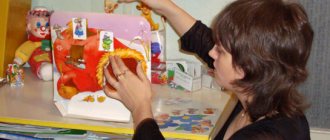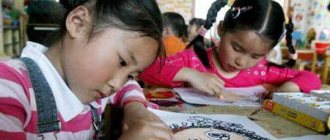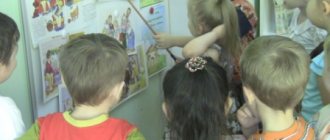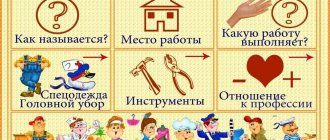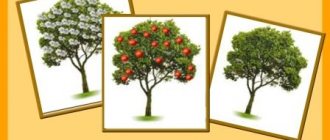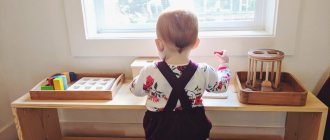Topic: "Family"
Integration of educational areas: “Cognitive development”, “Socio-communicative development”, “Physical development”.
Software tasks:
Educational field “Speech development”:
- Expand the active and passive vocabulary of children on the lexical topic “Family”; acquaintance with family members: mother, father, brother, sister, grandmother, grandfather, aunt, uncle, grandson, granddaughter, son, daughter, their qualities, character traits, activities).
- Practice the practical use of the category T.p. with the preposition -s, nouns with a general meaning.
- Strengthen the ability to form and use nouns with diminutive suffixes in speech.
Educational area "Cognitive development":
- To form ideas about the composition of the family, to introduce family ties in the family (brother, sister, parents, grandmother, grandfather, son, daughter, grandson, granddaughter).
- Develop visual and auditory perception, attention, memory, coherent speech.
Educational field “Social and communicative development”:
- Continue to work on forming friendly relationships between children, the ability to work collectively.
Educational field "Physical development":
- Develop gross motor skills and fine motor skills of the hands.
Equipment:
- picture material on the topic, family photographs.
GCD in the senior speech therapy group on the topic: “Family.”
Summary of educational activities in the senior speech therapy group on the topic: “Family.”
Program content
Correctional educational tasks:
- consolidate children’s knowledge about the family, its composition, family relationships;
- continue work on teaching the agreement of nouns with adjectives, nouns with numerals;
- learn to form the comparative degree of qualitative adjectives;
- continue work on the practical use of quality adjectives in speech;
— consolidate the ability to correctly construct and use complex sentences in speech;
- develop attention and logical thinking;
- continue to work on the clarity of diction and intonation expressiveness of speech.
- continue to work on the use of prepositions in speech: for, behind, before, about.
Correction and development tasks:
development of visual attention and perception, general motor skills, coordination of speech with movement.
Correctional and educational tasks:
— to cultivate in children an affectionate and sensitive attitude towards family members;
- cultivate a sense of family cohesion (based on ideas about the family, its composition, relationships).
INTEGRATION OF EDUCATIONAL AREAS
Cognitive development:
Continue to expand children's horizons.
Social and communicative development
To develop children’s ability to communicate freely with adults and children.
Speech development
Develop all components of children's oral speech.
Artistic and aesthetic development
Cultivate sensitivity to the artistic word.
Introduce children to verbal art, artistic perception of poetic texts.
Physical development
Develop coordination of speech and movement.
Promote the formation of correct posture, the development of gross and fine motor skills, and strengthen vision.
Practice the ability to relieve emotional and physical stress.
Progress of the lesson
I.Organizational part
- Hello, my dears! Let's say hello to our guests! Now it’s winter outside, but in our group it’s warm, light and fun! It’s fun from our bright smiles, because every smile is a little sun, which makes you feel warm and good. I now suggest passing on little sunshine to each other, getting to know each other and giving everyone a good mood! (I'm Kirill, I'm in a cheerful mood)
II . Introduction to the topic
Guys, today Luntik came to our lesson. Look what he has in his hands?
That's right, it's chamomile. Luntik hurried towards us and the petals scattered along the road. Can we help you collect the petals? We will add one petal to the flower to complete the task.
Guys, chamomile is a symbol of family, love and fidelity. Today in class we will talk about our families, how friendly they are and how much you love them.
Summary of a subgroup speech therapy lesson in the senior group on the topic: Family
Summary of a subgroup speech therapy lesson in the senior group on the topic: “I know that I have a very friendly family.”
Description of the material : I offer you a summary of the direct educational activities of children in the senior group on the topic: “I know that I have a very friendly family.” The material will be of interest to speech therapists, teachers and other preschool specialists. This summary may be entertaining. Integration of educational areas: “Cognition” (formation of a holistic picture of the world), “Socialization”, “Communication”, “Physical education”, “Health”, “Music”. Goal: To form in children a correct idea of the family, the role of father, grandfather, grandmother, sister, brother. Objectives: 1. Clarify and generalize children’s knowledge about the family, about who their relatives are. 2. Strengthen the understanding of the work responsibilities of family members. 3. Train children in the ability to ask questions and choose the right adjectives and verbs for words. 4. Develop coherent speech, cognitive interests, logical thinking. 5. Cultivate love and respect for your family members. Preliminary work: 1. Learning the last name, first name, patronymic and profession of parents. 2. Looking at family photos. 3. Making a family tree by parents. 4. Drawing pictures on the theme “My family.” Equipment: Family photographs, tree diagram, basket, bees, teddy bear from the puppet theater, photo exhibition.
Progress of the lesson:
Speech therapist: Children, let's imagine that we were all invited to a television studio for a children's program - “My Family”. Do you agree to be participants in this program? (Children's answers). Then let's quietly enter the television studio and take our seats. (Children sit on chairs to the music). Are the TV show participants ready? (Children's answers). Well, then we started. — Good afternoon, dear TV viewers. We are starting our program - “My Family”, and I, its presenter Galina Vladimirovna, greet you. Today in our studio there are guests of the program and participants, children of the Vesnyanka kindergarten in the village. Chertkovo. I invite participants to introduce themselves. Children: My name is..., my last name is.... Speech therapist: - Now I will tell you a riddle and, having guessed it, you will find out the topic of our conversation. The people who are dearest and closest to me, without whom I cannot live. We always take care of each other. This is my friendly... family. (Children). - That's right, today we will talk to you about family. - Children, listen, someone is rushing to our studio. Little Bear: - Hello, guys! You recognized me? My name is Mishutka. Guess which fairy tale I came to you from? Yes, I come from the fairy tale "The Three Bears" and I want to show you a photo of my family. This is dad - Mikhailo Potapych, he is big and strong, and this is mom - Nastasya Petrovna, she is kind and affectionate, and this is me - Mishutka. Our family is small, only three people. I love mom and dad very much. They also love me very much and care about me and each other. Guys, do you have a family? Tell me about your family and how you live. Speech therapist: Children, let’s tell you on our fingers about your family. Finger game: “My family.” — Today we have a photo exhibition on our TV show, many of you made a photo collage with your parents. Our TV viewers and Mishutka will be interested in hearing stories about your families. (Children tell: who is depicted; their parents’ names, where they work, where they filmed). - Who is our brother, who is our friend, quickly stand in the circle! Let's take each other's hands and start playing now. Game: “Who are you to me?” Children in a circle, the teacher asks: “I am a mother, and who are you to me?” (Daughter, son)… . Speech therapist: - Children, today we talked a lot about family, and now I want to tell you that a family is like a huge tree, the roots of this tree are the parents of your grandparents (your great-grandparents). The thick branches of the tree are grandparents. The thinner branches are your fathers and mothers, and the thinnest branches are you children. Now let's listen to children who have not yet talked about their family. (Story by 1-2 children). Physical exercise: “Who lives in our apartment?” Who lives in our apartment? One two three four. (We clap our hands.) Who lives in our apartment? (We walk in place.) One, two, three, four, five. (Jumping in place.) I can count everyone: (We walk in place.) Dad, mom, brother, sister, (Clap our hands.) Murka the cat, two kittens, (Tilts the body to the right and left.) My cricket, the goldfinch and me - (Turns the body left and right.) That’s my whole family. (Clap our hands.) Speech therapist: Children, I am very glad that each of you has a home where you are loved, waited for and cared for. -And if one of the family members is in a bad mood, what words can you use to correct it? You know such magic words , then let's play: 1. An ice block will melt, from a warm word - thank you 2. An old stump will turn green when you hear - good afternoon! 3. When people scold us for pranks, we say, please forgive me. - I see you are very attentive, kind children. In my hands (the game is being played) “Basket of Good Deeds” bees live in it. You need to catch a bee, put it in a basket and name the good deed that you are doing at home. (Music sounds, children take turns naming their chores). Speech therapist: Children, guests came to our TV show. Let's invite them to the studio. Please come in and have a seat. Our guests are Artem Reshetnikov’s mother, Ekaterina Petrovna, and Yurchenko Bogdan’s mother, Natalya Viktorovna. Dear guests, our children have already told us what tasks they carry out in their family, and now they want to know how responsibilities are distributed among adults. Can we ask you a few questions? And so the first question. (Children ask their own questions: who in your family goes to work, knits socks, bakes pies, hammers nails...). -Thank you very much to our guests for participating in the TV show.
We recommend watching:
Summary of an individual educational activity with a 5-6 year old pupil on the correction of sound pronunciation Summary of a subgroup lesson for children 5-7 years old in kindergarten on sound automation [R] Subgroup speech therapy lesson on the formation of phonemic functions in the senior group of children Synopsis of a subgroup speech therapy lesson on sound automation R in proposals
Similar articles:
Summary of educational activities in the older group of children with severe speech impairments on the topic: “Sounds S - Z”
Summary of educational activities in the senior group of children with severe speech impairments on the topic: “Sounds S - Sh”
Summary of a subgroup GCD to eliminate disturbances in sound pronunciation in children of the older group with severe speech impairments
Summary of educational activities in the senior speech therapy group on the topic “Cossacks and their traditions”
Logorhythmic lesson for children of senior preschool age with special needs on the topic: “What types of transport are there?”
